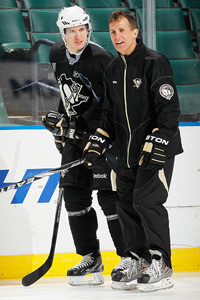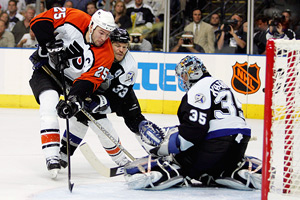86.51st Overall
Should Sydney Crosby Play Again This Year?
Sidney Crosby has hoisted a Stanley Cup and scored the dramatic gold-medal-winning overtime goal for Canada at the 2010 Winter Olympics in Vancouver. But now his career is complicated by other images: the two violent hits to the head that Crosby suffered in back-to-back games in January, hits that left him sidelined with a belatedly diagnosed concussion just as the 23-year-old Penguins superstar was riding a transcendent scoring streak unmatched in the NHL in 20 years. So the sight of Crosby finally returning to the ice in the past week for a few of Pittsburgh's morning team skates was encouraging progress.
But that's all it should be allowed to be.
The NHL playoffs will begin next week, and the pull on Crosby to come back to play is enormous even though he's just been cleared for only light exercise, not full-contact drills. The culture of hockey constantly pushes players to play on, through anything. And the yearning among Penguins teammates for Crosby's dramatic return is obvious, too, even if the team has played astonishingly well without him and fellow star
Evgeni Malkin, who's out for the season with a knee injury. As Penguins right wing
Arron Asham gushed to the Pittsburgh Post-Gazette after Crosby's first skate back on March 31, "I'm pretty sure he could lace them up tonight and be a force."
[+] Enlarge
Joel Auerbach/Getty ImagesSidney Crosby shared a few moments on the ice with assistant coach Tony Granato during a team workout April 1.
Crosby is that good.
But Penguins management should step up and make this decision for Crosby now: announce he won't be back for the rest of the season.
Take Crosby off the hook and say:
This is on us, Sid.
Continue to let him work out in all the morning skates he wants, if only to break the tedium of his recovery or to be back among his teammates. "I'd never want to take hope away from a player," Penguins general manager Ray Shero said upon Crosby's limited return last week. That's understandable, but end it there. Stop the growing noise about Crosby coming back for some dramatic Stanley Cup run before such talk snowballs any more.
Shero has steadfastly said there's no timetable to bring Crosby back. But the franchise should go further. Restate clearly, unequivocally that the postconcussion symptoms that Crosby has been suffering are signs that this is not the sort of injury anyone can "will" himself back from -- not even hockey players. Shutting him down is the only action that makes sense. Keep reminding people that medical experts and others who have been studying this issue for years don't know enough to predict whether it's safe for Crosby to return.
Crosby is just days into finally skating a little without getting symptoms. But that doesn't mean he should take another hit any time soon.
The Penguins should fight everything that the culture of hockey suggests and instead give into one thing that concussion experts can say with total certainty:
"We can be sure that more rest won't harm him; more rest would only help," says Blaine Hoshizaki, a biomechanics and neurophysics scientist who has studied how concussions occur.
Along with his research team at the University of Ottawa Neurotrauma Impact Science Laboratory, Hoshizaki has recreated thousands of brain injuries, including many NHL and NFL concussions, during the past few years. His work includes some videotape studies of the injurious hits on Crosby and Montreal's
Max Pacioretty that should leave you never looking at the hits that athletes routinely absorb quite the same way.
Hoshizaki's work helps create safer equipment, and he studies what sort of hits -- straight-on (or linear) versus angular (or sideways) impacts -- cause brain trauma. He emphasizes, "The work we do doesn't speak to return-to-play guidelines, though it could in the long run. But it's clear even just from a business standpoint, to bring Crosby back at this point makes no sense at all. Not for his future. Not for his team or his league. They're not going to sell one more tickets by bringing him back. And the long-term risk is just not worth it, not even if they did go on to win the Stanley Cup.
[+] Enlarge
Joel Auerbach/Getty ImagesPenguins fans would love to see Sidney Crosby back in the lineup for the playoffs.
"As our recreations showed, what he suffered was a high-risk hit that resulted in a high-risk brain injury."
The two hits that sidelined Crosby are bad enough when seen just with the naked eye or in normal slow-motion replay. The first -- a shoulder to the side of Crosby's head from then-Washington forward
David Steckel, who blindsided Crosby in the NHL Winter Classic on Jan. 1 -- snapped Crosby's neck back and sent his 200-pound body helicoptering through the air before he slammed to the ice. When Crosby finally tried to get up, he was groggy and barely holding onto his mouthpiece. Eventually, he somehow skated, still doubled over, back to the bench. He played in the Penguins' next game four nights later despite a sore neck only to have Tampa Bay's
Victor Hedman slam his head against the Plexiglas boards with loud bang and rattle. Again, Crosby crumpled to the ice.
Three months later, he has yet to play.
But as jarring as both hits look, the Steckel hit acquires a far more disturbing dimension in videos of lab simulations Hoshizaki and his team have done using a crash test dummy's head that's wearing a hockey helmet and then slammed with a padded arm at the precise angle, speed and place that Crosby was hit by Steckel. The scientists calculated the 217-pound Steckel was traveling at nearly 20 mph and delivered an instantaneous peak force of approximately 850 pounds to the side of Crosby's head.
The beeping countdown before the blow is enough to make you queasy even before you see and hear what's coming next in the
video: a loud impact that sends the dummy's head snapping sideways and rotating around on its cantilevered neck just as Crosby's did in real life. Hoshizaki explains that most of this detail is not discernible to the naked human eye, which can comprehend things at only about 25 to 26 frames a second. When recorded at about 2,000 frames a second in the lab and played back more slowly, the violence of the impact Crosby's head absorbed is gruesome.
The same goes for the NISL's
recreation of a hit that Montreal's Max Pacioretty took in March from 6-foot-9 Boston defenseman
Zdeno Chara. That hit left Pacioretty concussed and temporarily unconscious, and it broke a vertebra in Pacioretty's neck, touching off an even bigger firestorm and national debate than the hits on Crosby.
Watching the Pacioretty recreation, you wonder how his head didn't roll off.
Both videos help illustrate why athletes' brains get hurt, and stay hurt -- sometimes for years.
They also should be enough evidence to silence all these ersatz tough guys who are shouting that Crosby "owes it" to Penguins to try to return if his symptoms stay away.
No. He doesn't.
And the encouraging thing is, Crosby seems to be taking the safety-first advice he's been getting from Penguins management and many of the former and current players he and his agent, Pat Brisson, have contacted.
[+] Enlarge
Harry How/Getty ImagesKeith Primeau had a magical playoff run in 2004 that almost resulted in a Stanley Cup. That was basically the end of his career.
One of them is
Keith Primeau, a bruising star center who found himself at a juncture similar to where Crosby is now and decided to play through two concussions he suffered during the 2004 NHL playoffs. Primeau played spectacularly, driving the Flyers one win short of reaching the Stanley Cup finals. But Primeau missed 73 games the next season. He finally, begrudgingly, tearfully admitted he had to retire after trying another comeback in September '06 when Flyers trainer Jim McCrossin told Primeau he could never in good conscience clear him to play again.
Primeau, now 39, says that bluntness was the sort of reality check he needed at the time. Nearly five years removed now from his last game, he admits, "I didn't have a very good summer or fall last year." Meaning? "I still have postconcussion symptoms -- head pressure, vision problems, headaches, an inability to exercise sometimes without getting dizzy and nauseous."
But Primeau isn't keeping quiet about it. Just this week, in conjunction with partners such as Sports Safety Labs, Primeau launched a program called StopConcussions.com, and a related, free iPhone application.
"Right now, the app is just the first generation of it, but we hope to develop it even more going forward," Primeau says. "It's a free download that helps people access things like a $5 cognitive assessment test that allows parents or coaches or trainers to have something readily available to check a player's condition who might have a concussion. There's also a Google maps feature where you enter information and can find the nearest medical center to your location if, for example, you're at a sporting event and think you need to get someone help quickly."
Primeau hopes it will be one more tool that can make a difference. "But my fear," he says, "is that there's this thought process now [about the seriousness of concussions] that is going to go away. That it's just the injury du jour. The ACL injury of 2011."
Neither Hoshizaki nor Primeau goes as far as Dr. Paul Echlin, who slammed the Penguins' handling of Crosby's initial hit. "All the red flags [were] up," Echlin told Maclean's magazine in February. "To have a player concussed a second time is completely irresponsible."
But both Hoshizaki and Primeau say the NHL is not doing all it can despite rule changes that ban some hits to the head and recent changes to the protocols on how players who may have concussions are assessed during games.
"We work with people in hockey and the NHL all the time, and in my view they still need to be more educated." Hoshizaki said. "Part of it goes back to the culture of the sport. I'm not sure the resolve is there yet."
"The NHL is trying, but it's not moving fast enough." Primeau said.
The Penguins can control that. They can do Crosby a favor. Sometime in the next week, the team needs to sit Crosby down and say,
We love you, miss you and desperately want to have you back for Stanley Cup playoffs, kid.
But not this season.
"I couldn't say it for myself at the time, but I can now, and I told Sidney's agent this -- it's just not worth it," Primeau said.






